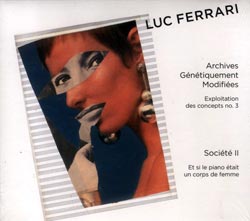
Archives Génétiquement Modifées / Société II collects two Luc Ferrari compositions separated by 31 years to effective results. The disc opens with Archives Génétiquement Modifées: Exploitation des concepts no. 3, a sampling collage from 2000 that carries the subtitle "for memorized sounds." Ferrari continues the concept introduced in Exploitation des concepts no. 1, creating a new work by ransacking his own archives, using his recordings from the 1960s as sound sources, as if reworking his own memories. The 25-minute piece is divided into six sections, and it is probably only the most devout Ferrariphile who will recognize the seeds of the piece. Ancient synthetic whoops and whirs meld with stumblingly forced rhythms and occasional instrumental voices in a strangely cohesive way reminiscent of the atmospheric turntable work of Philip Jeck and Janek Schaefer. The echo chamber of foreboding tones and punctuating beats is, at times, fairly haunting.
The second half of the disc turns back to the period just plundered with the 1967 composition Société II: Et si le piano était un corps de femme for sixteen instruments and four soloists. The 1968 recording by the Ensemble Instrumental de Musicque Contemporaine de Paris is an exciting amalgam of quick cuts and rolling attacks, presaging the compositional influences later used by John Zorn in his chamber works. The epigram is translated as "And if the piano were a body of a woman," and the piece realizes that in an odd manner, full of acoustic violence and unresolved threats lobbed across an ensemble of flute, oboe, clarinet, bassoon, French horn, trumpet, trombone, three percussionists, nine strings and, of course, piano. Ferrari wrote at the time that the piece could be seen as a group of musicians competing for the "interest of the body of the piano, which remains hopelessly cold. One could almost find there, if one wanted, but it is not certain, the caricature of a macho society." Twenty-two years later, the composer amended that to say that the piece "actually shows the extravagant qualities of the piano in its harmony, imagination and brutality." While the 1960s description is more colorful, both hold true. The challenges are not just to the listener, but carry forth within the ensemble.
Comments and Feedback:



More Recent Reviews, Articles, and Interviews @ The Squid's Ear...


|

